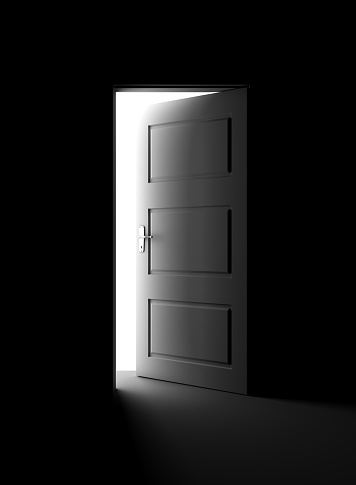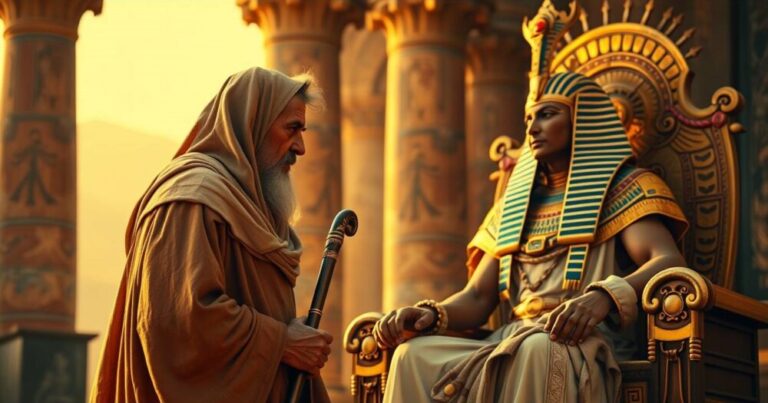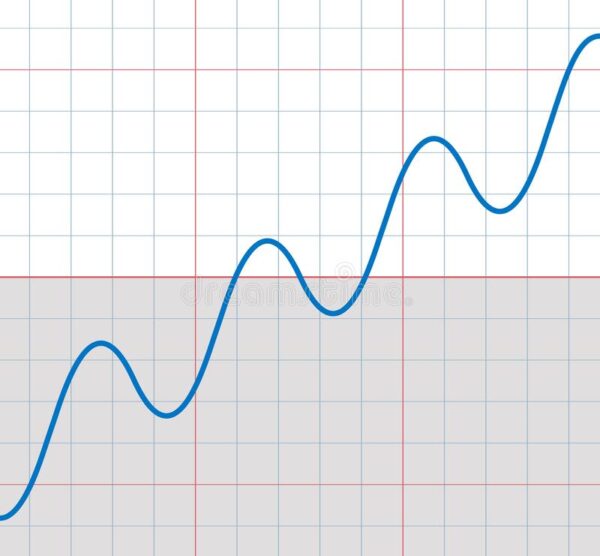Doors in the Dark

Likutei Moharan 9 and the Light of Chanukah
In last week’s issue of The Shoemaker Report, we learned about the halachah of placing the Chanukah light within ten tefachim of the ground. Since we are still basking in the light of the days of Chanukah, let’s take the time to learn the meaning behind another halachah dealing with the lighting of the menorah during Chanukah.
It is taught in the Gemara (Shabbat 22a): אָמַר רַבָּה נֵר חֲנוּכָּה מִצְוָה לְהַנִּיחָהּ בְּטֶפַח הַסָּמוּךְ לַפֶּתַח וְהֵיכָא מַנַּח לֵיהּ רַב אַחָא בְּרֵיהּ דְּרָבָא אָמַר מִיָּמִין רַב שְׁמוּאֵל מִדִּפְתִּי אָמַר מִשְּׂמֹאל וְהִילְכְתָא מִשְּׂמֹאל כְּדֵי שֶׁתְּהֵא נֵר חֲנוּכָּה מִשְּׂמֹאל וּמְזוּזָה מִיָּמִין (Rabbah said, ‘It is a mitzvah to place the Chanukah light within one tefach of the entrance.’ And where does one place it? Rav Acha the son of Rava said, ‘On the right.’ Rav Shmuel from Difti said, ‘On the left.’ And the halachah follows Shmuel so that the Chanukah light will be on the left and the mezuzah on the right). This is also brought down in the Shulchan Aruch as the fundamental halachah (Orach Chaim 671:7): מצוה להניחו בטפח הסמוך לפתח משמאל כדי שתהא מזוזה מימין ונר חנוכה משמאל (It is a mitzvah to place it within one tefach of the entrance on the left in order to have the mezuzah on the right and the light of Chanukah on the left).
R' Nachman teaches (Likutei Moharan 9:1): כִּי עִקַּר הַחִיּוּת מְקַבְּלִין מֵהַתְּפִלָּה כְּמוֹ שֶׁכָּתוּב: "תְּפִלָּה לְקֵל חַיָּי". וּבִשְׁבִיל זֶה צָרִיךְ לְהִתְפַּלֵּל בְּכָל כֹּחוֹ כִּי כְּשֶׁמִּתְפַּלֵּל בְּכָל כֹּחוֹ וּמַכְנִיס כֹּחוֹ בְּאוֹתִיּוֹת הַתְּפִלָּה אֲזַי נִתְחַדֵּשׁ כֹּחוֹ שָׁם (We receive the essence of our life-force from tefillah, as it is written [Tehillim 42:9]: ‘A tefillah to the G-d of my life’. And because of this, it is necessary to pray with all of one’s strength because when one prays with all of one’s strength and concentrates all of one’s energy into the letters of tefillah, then his strength is renewed there). This sounds very inspiring, but the fact of the matter is that many of us are distant from this ideal and end up in places where we don’t really want to be (L.M. 9:3): אֲבָל כְּשֶׁאָדָם עוֹמֵד לְהִתְפַּלֵּל אֲזַי בָּאִים מַחֲשָׁבוֹת זָרוֹת וּקְלִפּוֹת וּמְסַבְּבִין אוֹתוֹ וְנִשְׁאָר בַּחשֶׁךְ וְאֵין יָכוֹל לְהִתְפַּלֵּל (However, when a person stands to pray, foreign thoughts and klipot come to surround him, and he is left in the darkness unable to pray). How can we be spared from this fate?
Our Sages taught (Yoma 38b): בָּא לִטַּמֵּא פּוֹתְחִין לוֹ (If one comes to defile himself, they open up for him [opportunities to defile himself]). R' Nachman provides us with a deeper understanding of these words—‘if one comes to defile himself [thus finding himself in the dark], they provide him with doors [to get out of the darkness]. Both ways of understanding these words are correct, but we want to focus on the solution, i.e. getting out of the darkness. The good news is that there are many doors in the darkness: if we could just find one, we could exit the darkness and enter the light. The challenge is (L.M. 9:3): הָאָדָם הוּא עִוֵּר וְאֵין יוֹדֵעַ לִמְצֹא הַפֶּתַח (The person is blind and doesn’t know how to find the door). This doesn’t just have to do with our prayers. It can pertain to other areas of our lives as well. In other words, the solutions to getting ourselves out of our predicaments are usually right in front of our face, but because we’re in the dark, we can’t see them.
This is like Hagar after she was dismissed from the home of Avraham and Sarah. She ended up in the desert having run out of her water with her son Yishmael close to death. At wits end, she cried and cried, not knowing what to do. After being visited by angels, something even more extraordinary happened (Bereshit 21:19): וַיִּפְקַח אֱלֹקִים אֶת־עֵינֶיהָ וַתֵּרֶא בְּאֵר מָיִם (And G-d opened her eyes and she saw a well of water). Astonishing, is it not? The well was right there, the doorway out of her darkness was there in the darkness, but she was blind and couldn’t see it. This is true of all of us, at least some of the time. So what are we to do?
The first thing we should do is to concentrate on the words of the berachah that we make each morning before Shacharit: בָּרוּךְ אַתָּה יְיָ אֱלֹקֵינוּ מֶלֶךְ הָעוֹלָם פּוֹקֵחַ עִוְרִים (Blessed are You, Hashem, our G-d, who gives sight to the blind). The blind person isn’t someone else—it’s us. And if we acknowledge this truth, we are on the right path, as it is taught (L.M. 9:3): וְדַע שֶׁעַל־יְדֵי אֱמֶת זוֹכֶה לִמְצֹא הַפֶּתַח כִּי עִקַּר אוֹר הַמֵּאִיר הוּא הַקָּדוֹשׁ־בָּרוּךְ־הוּא כְּמוֹ שֶׁכָּתוּב: "ה' אוֹרִי וְיִשְׁעִי" (Know that through truth one merits to find the door, for the main light that shines is the Holy One, blessed be He, as it is written [Tehillim 27:1], ‘Hashem is my light and my salvation’). At whatever level we’re on, in whatever way we can, speak the truth, especially to ourselves. If we get used to doing this, we will see the doors and we will be able to exit the darkness and enter the light, as it is written (Tehillim 43:3): שְׁלַח־אוֹרְךָ וַאֲמִתְּךָ הֵמָּה יַנְחוּנִי (Send Your light and Your truth; they will lead me).
This is the secret of the צֹהַר [tzohar] that Noach was told to place in the ark (Bereshit 6:16): צֹהַר תַּעֲשֶׂה לַתֵּבָה וְאֶל־אַמָּה תְּכַלֶּנָּה מִלְמַעְלָה (A tzohar you shall make for the ark, and it shall end one amah from the top). As explained by Rashi in his commentary to Bereshit 6:16, there are two different approaches to understanding the essence of this tzohar: יֵ"אֹ חַלּוֹן וְיֵ"אֹ אֶבֶן טוֹבָה הַמְּאִירָה לָהֶם (Some say it was a window and others say it was a precious stone that provided illumination for them). What does this really mean? A window has no light in itself; it allows light to pass through it only if there is light on the outside. However, a luminous precious stone has light within itself and can provide light even when there is no light on the outside. This is how R' Nachman explains it (L.M. 9:3): כֵּן יֵשׁ בְּנֵי־אָדָם שֶׁדִּבּוּרָם הוּא חַלּוֹן וְאֵין כֹּחַ לְהָאִיר לָהֶם בְּעַצְמָם וְזֶה 'יֵשׁ אוֹמְרִים' וַאֲמִירָתָם נַעֲשֶׂה חַלּוֹן וְיֵשׁ שֶׁאֲמִירָתָם נַעֲשֶׂה אֶבֶן טוֹב וּמֵאִיר (Some people’s speech are a window with no ability to shine for them on their own. This is the meaning of Rashi’s words ‘some say’, i.e. their ‘saying’ makes a window, and there are others whose ‘saying’ makes a luminous precious stone). It all depends on the quantity and quality of truth that we speak. This truth is hinted at in the verse itself. The first letters of the final phrase "וְאֶל־אַמָּה תְּכַלֶּנָּה מִלְמַעְלָה" (and it shall end one amah from the top) can be arranged to spell the word אמת [truth]. This is what Hashem really desires, to dwell with those who speak the truth, as it is written (Tehillim 145:18): קָרוֹב יְיָ לְכׇל־קֹרְאָיו לְכֹל אֲשֶׁר יִקְרָאֻהוּ בֶאֱמֶת (Hashem is near to all who call to Him, to all who call to Him in truth).
Let’s now connect all of this to the Chanukah light and the mitzvah of placing it next to the door (Likutei Halachot, Orach Chaim, Chanukah 6:1): וְשָׁם דַּיְקָא מַדְלִיקִין נֵר חֲנֻכָּה סָמוּךְ אֵצֶל הַפֶּתַח בִּבְחִינַת פֵּתַח דְּבָרֶיךָ יָאִיר וְכוּ' לְהוֹרוֹת שֶׁדַּיְקָא לְמַטָּה מֵעֲשָׂרָה טְפָחִים בִּמְקוֹם אֲחִיזַת הַסִּטְרָא אָחֳרָא גַּם שָׁם יְכוֹלִין לִמְצֹא הַפֶּתַח לְהִתְקָרֵב אֶל הַקְּדֻשָּׁה עַל-יְדֵי אוֹר הָאֱמֶת שֶׁיְּכוֹלִין לְהַמְשִׁיךְ הָאֱמֶת גַּם שָׁם וְעַל-יְדֵי אוֹר הָאֱמֶת שֶׁהוּא בְּחִינַת נֵר חֲנֻכָּה יְכוֹלִין לְהִתְקָרֵב לְהַשֵּׁם יִתְבָּרַךְ בְּכָל מָקוֹם אֲפִלּוּ לְמַטָּה מֵעֲשָׂרָה טְפָחִים שֶׁאֵין שָׁם הַשְׁרָאַת הַשְּׁכִינָה כִּי יְכוֹלִין לִמְצֹא הַפֶּתַח עַל-יְדֵי אוֹר הָאֱמֶת כַּנַּ"ל (And specifically there [below ten tefachim] we ignite the Chanukah light close to the door, which corresponds to ‘The doorway [peitach] of your words will shine’ [Tehillim 119:130], to teach that specifically below ten tefachim in the place where the Sitra Achra has an exclusive hold, even there we can find the door to draw close to holiness through the light of truth, that we are able to draw down the truth even there, and through the light of truth which is an aspect of the Chanukah light, we can draw close to Hashem, may He be blessed, in any place, even below ten tefachim where the Shechinah doesn’t rest, because we can find the door through the light of the truth). This is why one should never give up and never despair. The whole world is filled with Hashem’s glory.
One final aspect which we haven’t touched upon yet—the reason behind placing the Chanukah light on the left side of the door. Why the left? As our Sages teach, since the mezuzah is on the right, we place the menorah on the left in order to be surrounded by mitzvot. Let’s see if we can probe a little deeper to understand what this means.
When Kayin killed Hevel, Hashem told him (Bereshit 4:7): הֲלוֹא אִם־תֵּיטִיב שְׂאֵת וְאִם לֹא תֵיטִיב לַפֶּתַח חַטָּאת רֹבֵץ וְאֵלֶיךָ תְּשׁוּקָתוֹ וְאַתָּה תִּמְשׇׁל־בּוֹ (Isn’t it true that if you do good, you will be forgiven? But if you do not do good, sin lies at the door, and its desire is for you, yet you can rule over it). About which door is Hashem speaking? It is taught (Avot d’Rabbi Natan 16:3): ויצר הרע אינו שרוי אלא על מפתחי הלב שנאמר לפתח חטאת רובץ (The Evil Inclination rules only over the doors of the heart, as it says [Bereshit 4:7], ‘sin lies at the door’). So where exactly is the Evil Inclination positioned as it lies next to the door? It is written in Kav ha-Yashar 1:12: לָזֶה צָרִיךְ לֵידַע מַה שֶּׁכָּתוּב בַּזֹּהַר כִּי לְצַד שְׂמֹאל בַּפֶּתַח יֵשׁ סִטְרָא אָחֳרָא חַד וְעָלָיו נֶאֱמַר "לַפֶּתַח חַטָּאת רֹבֵץ" וְהַמְּזוּזָה הָרוֹמֶזֶת עַל שְׁכִינְתָּא קַדִּישָׁא קָבוּעַ מִיָּמִין (A person needs to know what is written in the Zohar that the Sitra Achra lurks on the left side of the door, and about this it was said [Bereshit 4:7], ‘sin lies at the door’, and the mezuzah alludes to the holy Shechinah permanently affixed on the right). To quote the Holy Zohar itself (Va’Etchanan 263b):סָמִיךְ לְפִתְחָא לָקֳבֵל תְּרֵין דַּרְגִּין אִזְדְּמַן חַד שִׁידָא וְאִית לֵיהּ רְשׁוּ לְחַבְּלָא וְאִיהוּ קָאִים לִסְטַר שְׂמָאלָא זָקִיף בַּר נָשׁ עֵינוֹי חָמֵי לֵיהּ לְרָזָא דִּשְׁמָא דְּמָארֵיהּ וְאִדְכַּר לֵיהּ וְלָא יָכִיל לֵיהּ לְאַבְאָשָׁא (Close to and opposite the door there are two aspects, one of holiness [the Shechinah which rests on the mezuzah] and one of the Sitra Achra, which is a demon [שד, a sheid], and he is given permission to harm, and he stands on the left side of the door, and if a person lifts up his eyes and sees the secret of the name of his Master [i.e., שד"י, which is on the mezuzah on the right side of the door] and remembers Him, then the demon isn’t able to harm him).
Even if you are not able to place your Chanukah on the left side of your door below ten tefachim (as we learned in last week’s teaching) for logistic constraints, don’t worry about it. Just do what you can. The important point is to understand and employ this amazing strategy of getting oneself out of all types of darkness—to focus on each word and letter of prayer and to train oneself to speak truth always. And, of course, give thanks to Hashem for the profound meanings bound up in every detail of our beloved mitzvot.
Chanukah sameach!






